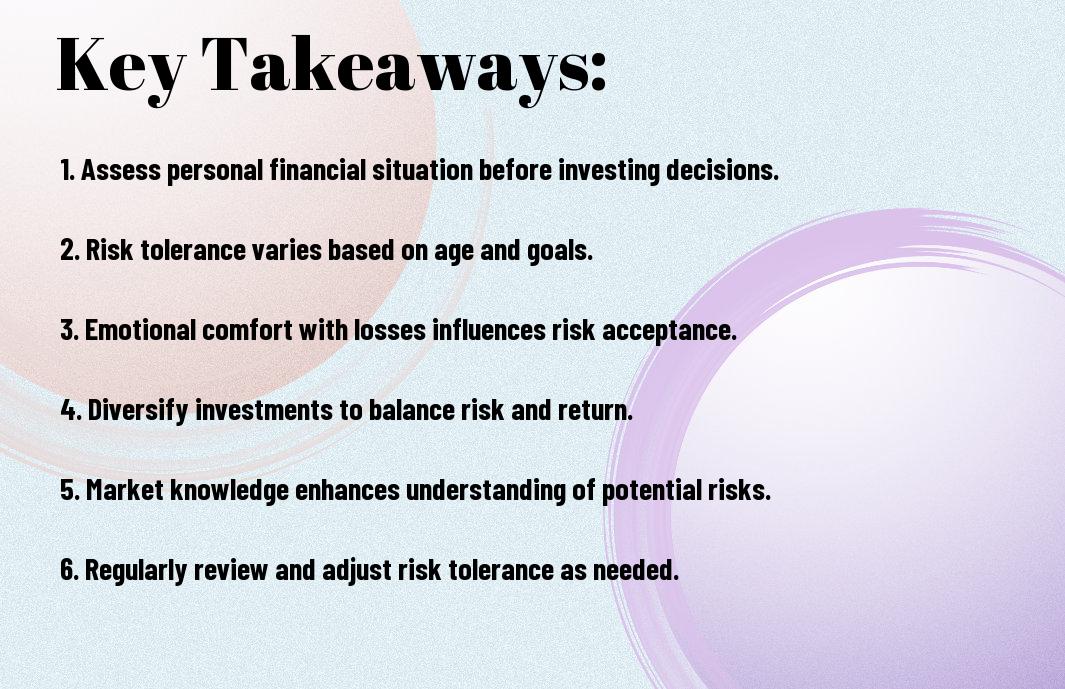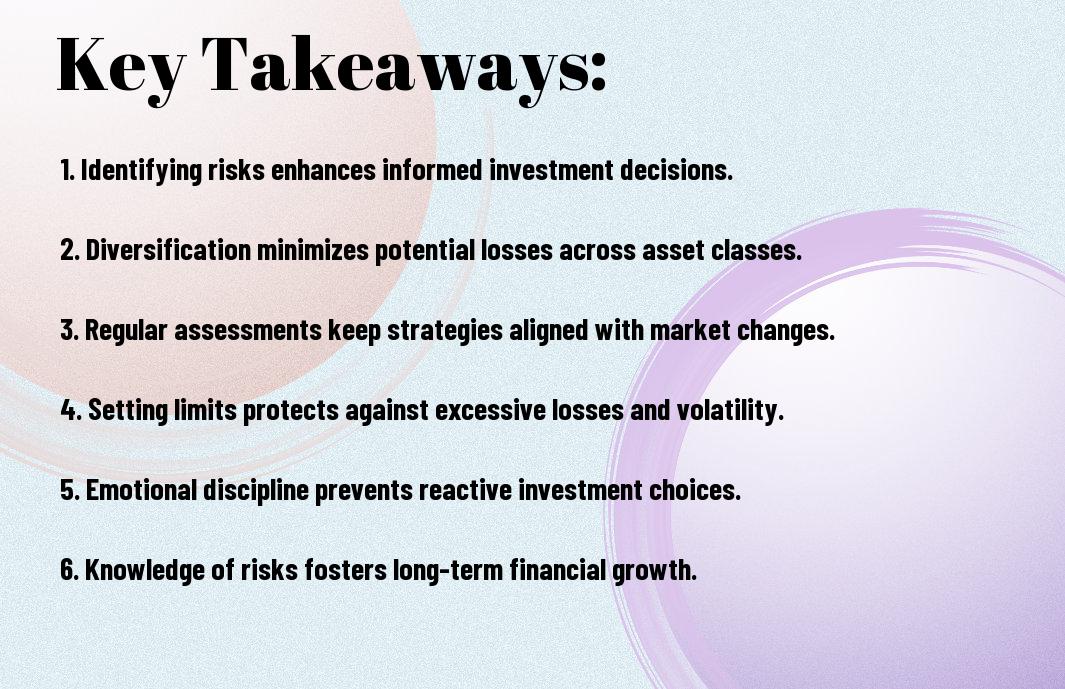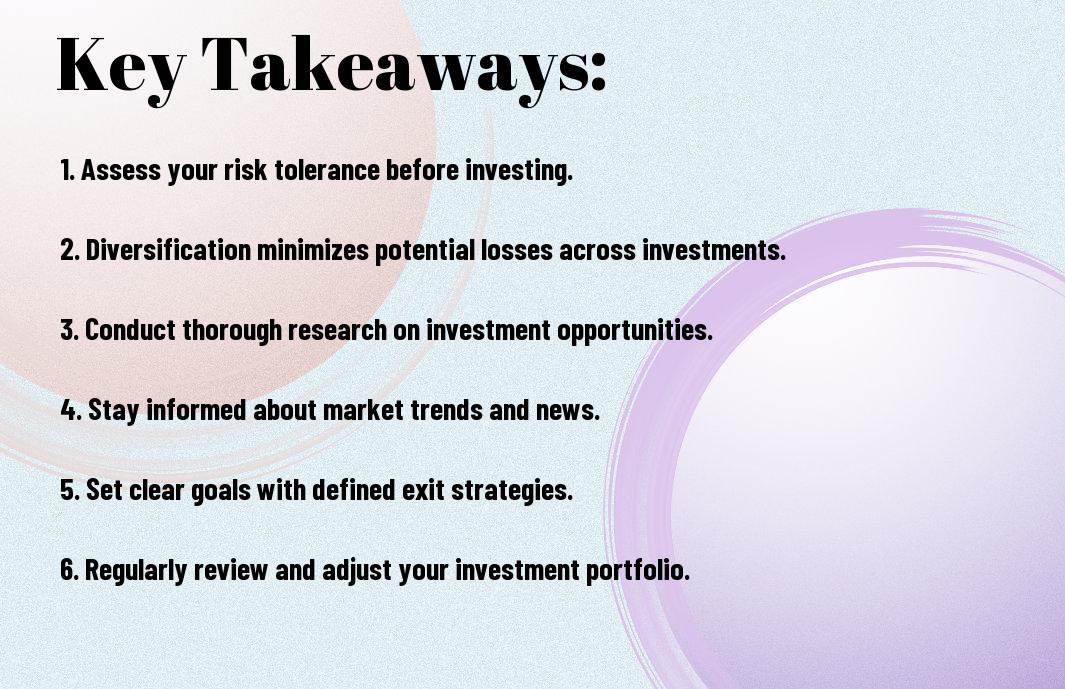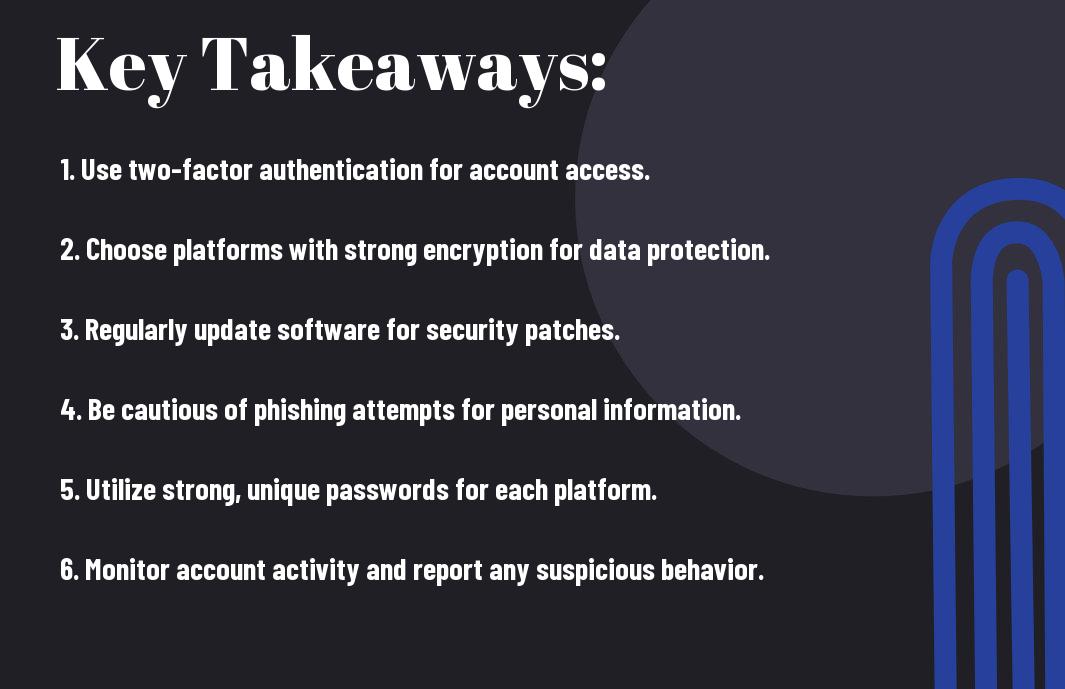Many investors struggle to identify their personal risk tolerance, which plays a significant role in shaping your investment strategy. Understanding how much risk you are willing to take is imperative for aligning your portfolio with your financial goals. By assessing your risk appetite, you can make informed decisions that not only reflect your comfort level but also enhance the potential for returns over time. This post will guide you through the factors that influence risk tolerance and offer tips for developing a strategy that suits your individual needs.
Key Takeaways:
- Risk Tolerance Assessment: Assessing your risk tolerance involves evaluating your financial situation, investment goals, and emotional comfort with market fluctuations.
- Investment Horizon: Your time frame for investing significantly influences your risk tolerance; longer horizons may allow for taking on more risk.
- Diversification Strategy: A well-diversified portfolio can help manage risk while aiming for desired returns, aligning with personal risk tolerance levels.
- Market Conditions: Understanding how market volatility impacts risk tolerance can guide investment decisions during different economic cycles.
- Periodic Review: Regularly reviewing and adjusting your risk tolerance is vital as personal circumstances and financial markets change over time.

Defining Risk Tolerance
The concept of risk tolerance is important for effective investing. It refers to the degree of variability in investment returns that you are willing to withstand while pursuing your financial goals. Understanding your Risk Tolerance – Overview, Factors, and Types of Tolerance enables you to create a personalized investment strategy that aligns with your comfort level and financial objectives.
The Concept of Risk Tolerance
Defining your risk tolerance involves evaluating your emotional and financial readiness to handle the ups and downs of market fluctuations. It often requires introspection about your financial goals, investment timeline, and the potential for losses.
Factors Influencing Risk Tolerance
Below are some key factors that influence your risk tolerance:
- Your age and investment timeline
- Your financial situation and obligations
- Your investment experience
- Your emotional predisposition to risk
Thou must consider how each factor affects your overall comfort with risk and performance expectations.
Risk tolerance is not a one-size-fits-all approach; it varies significantly depending on multiple personal factors. Different individuals may have varying perspectives on what constitutes acceptable risk, based on the following:
- Your personal and family financial responsibilities
- Your future income expectations
- Your investment knowledge and experience
- Your overall investment goals
Thou should assess these elements periodically, as life changes can result in varying levels of risk tolerance.
Risk Profiles
It is necessary to understand that risk profiles are categorized based on investors’ willingness and ability to take risks. Each profile correlates to different investment strategies and potential rewards. By identifying your risk profile, you can align your investment choices with your financial goals and comfort level, making informed decisions that suit your unique circumstances.
Conservative Investors
Profiles of conservative investors are characterized by a low risk tolerance, focusing on preserving capital rather than seeking high returns. You typically prioritize safety and stability, opting for investments like government bonds or blue-chip stocks that offer modest growth with minimal risk.
Moderate Investors
Moderate investors maintain a balanced approach between risk and reward, often blending conservative and aggressive assets. You may be comfortable with some fluctuations in your portfolio but prefer to minimize potential losses while still aiming for reasonable capital appreciation.
Indeed, as a moderate investor, you are likely to invest in a mix of bonds and stocks, ensuring that your portfolio remains diversified. This strategy allows you to benefit from the growth of equities while reducing the overall volatility through stable fixed-income securities. By understanding this balance, you can make informed investment choices that align with your comfort level.
Aggressive Investors
Between the various risk profiles, aggressive investors embrace a high-risk tolerance, often seeking substantial returns through volatile investments. You may pursue opportunities in emerging markets or high-growth stocks, fully aware that market fluctuations can lead to significant gains or losses.
In addition to seeking high returns, aggressive investors often engage in market timing or sector rotation strategies. You may also invest in leveraged funds or alternative assets, understanding that while these choices can increase potential rewards, they also elevate your exposure to risk. By adopting this bold approach, you aim to maximize your investment growth over time, willing to ride out market instability for the chance at substantial financial gain.
Assessing Your Risk Tolerance
Despite the various investment opportunities available, understanding your risk tolerance is key to aligning your financial goals with your investment strategy. Your tolerance for risk is influenced by factors such as your financial situation, investment timeline, and emotional capacity to handle market fluctuations. To enhance your understanding of this concept, consider referring to the Guide to investment risk tolerance.
Self-Assessment Tools
At your disposal are numerous self-assessment tools designed to evaluate your risk tolerance. These questionnaires can help you identify how comfortable you are with potential losses and gains. By answering a series of questions about your financial goals and emotional responses to risk, you gain insights into the types of investments that might suit you best.
Professional Assessments
Assessing your risk tolerance with the help of a financial advisor can provide you with a deeper understanding of your comfort level with investments. These professionals often employ comprehensive tools and methodologies to analyze your financial situation, which can yield a more personalized risk profile.
The advantage of professional assessments is that they consider both quantitative and qualitative factors, offering a well-rounded view of your risk tolerance. Advisors will engage in discussions about your financial goals, market perceptions, and emotional responses to risk, ensuring your investment strategy is aligned with your overall financial plan. This tailored approach not only provides clarity but also enhances your confidence in making informed investment decisions.

Aligning Investments with Risk Tolerance
Now that you understand your risk tolerance, it’s vital to align your investments accordingly. This alignment helps you create a portfolio that reflects your comfort level with market fluctuations, enabling you to stay invested for the long haul. By selecting investment vehicles that match your risk profile, you can optimize your chances for growth while minimizing the stress associated with potential losses.
Portfolio Diversification
Among the most effective ways to align your investments with your risk tolerance is through portfolio diversification. By spreading your investments across various asset classes, sectors, and geographical regions, you can mitigate the impact of poor performance in any single investment. This strategy allows you to pursue higher returns while still maintaining a level of safety that corresponds with your risk comfort.
Risk Management Strategies
At the core of any effective investing approach are risk management strategies that safeguard your investments. By employing techniques such as stop-loss orders, position sizing, and regular portfolio reviews, you can manage potential losses and protect your investment capital. These strategies are vital in navigating market volatility and ensuring that your investments remain aligned with your risk tolerance.
Indeed, risk management strategies encompass a range of techniques designed to shield your investments from significant losses. Implementing stop-loss orders allows you to set predetermined limits on losses, while regular assessment of your portfolio can help you identify and respond to emerging risks. Position sizing further helps you control how much capital you allocate to each investment, which is vital for maintaining long-term alignment with your risk tolerance. By incorporating these strategies, you can not only protect your investments but also enhance your confidence in the face of market fluctuations.
Behavioral Aspects of Risk Tolerance
Keep in mind that understanding your risk tolerance involves more than just numbers; it incorporates your emotional and psychological responses to investing. Your feelings about market fluctuations can significantly influence your decisions, pushing you toward more conservative or aggressive choices. Recognizing these behavioral aspects can help you align your investment strategy with your actual comfort level.
Emotional Influence on Decision Making
Against what you might think, emotions play a pivotal role in your investment decisions. Fear of loss can lead to overly cautious behavior, while greed may push you toward reckless risk-taking. Balancing your emotional responses with rational analysis is key to making informed investment choices that align with your risk tolerance.
Cognitive Biases in Investing
At the same time, cognitive biases can distort your perceptions and decision-making processes in investing. These biases, such as overconfidence or confirmation bias, can lead you to hold on to losing investments or ignore vital information that contradicts your beliefs, ultimately impacting your portfolio’s performance.
Consequently, it’s vital to recognize and address these biases when you assess your risk tolerance. By understanding how these cognitive distortions work, you can develop strategies to mitigate their effects. For instance, maintaining a diversified portfolio can counteract overconfidence, while actively seeking out differing opinions can help you challenge confirmation bias. By doing so, you create a more balanced investment approach that aligns with your true risk tolerance.
Adjusting Risk Tolerance Over Time
All investors must recognize that risk tolerance is not a static concept. As your financial landscape evolves, your What Is Risk Tolerance and How Can You Determine Yours? may also change. Factors like life events, market fluctuations, and shifts in personal goals can influence how much risk you’re willing to take on. Regularly reassessing your risk tolerance will help you make informed investment decisions that align with your current situation.
Life Changes and Investment Strategies
One of the most significant triggers for adjusting your risk tolerance is life changes. Events such as marriage, starting a family, or nearing retirement can shift your financial priorities and, consequently, your comfort with risk. You may find that you’re inclined to adopt a more conservative approach as you prioritize stability and security for your future.
Market Conditions and Risk Appetite
Strategies to navigate shifting market conditions can greatly impact your risk appetite. As market dynamics change, you may find that your exposure to various asset classes needs realignment. A consistently volatile market could render you more risk-averse, while a bull market might encourage you to take on more aggressive investments.
Consequently, understanding the correlation between market conditions and your risk appetite is vital for effective investing. During downturns, you may instinctively feel the urge to retreat to safer investments; conversely, when markets are thriving, you might feel emboldened to explore higher-risk options. Regularly assessing your investment portfolio in the context of market performance can help you balance potential rewards with acceptable risks.
Summing up
Hence, understanding your risk tolerance is important for making informed investment decisions that align with your financial goals. By assessing your comfort level with potential losses and market fluctuations, you can build a portfolio that suits your unique needs and investment timeline. This self-awareness helps you navigate the complexities of the investment landscape more effectively, leading to more confident and strategic choices that ultimately contribute to your financial success.
FAQ
Q: What is risk tolerance in the context of investing?
A: Risk tolerance refers to the degree of variability in investment returns that an investor is willing to withstand. It encompasses an investor’s comfort level with the potential for losses and gains. Understanding your risk tolerance is necessary for making informed investment decisions, as it influences the types of assets you may choose, including stocks, bonds, or real estate. Various factors such as age, financial situation, investment goals, and psychological factors play a significant role in determining an individual’s risk tolerance.
Q: How can I assess my own risk tolerance before making investment decisions?
A: Assessing your risk tolerance involves evaluating various aspects of your financial situation and personal attitude towards risk. You can start by taking self-assessment questionnaires available through financial institutions or online platforms, which usually cover topics like investment goals, time horizon, and emotional reactions to market fluctuations. Additionally, consider factors such as your income, savings, current financial obligations, and investment experience. This holistic view will help you gauge how much risk you are comfortable taking on.
Q: How does my investment time horizon affect my risk tolerance?
A: Your investment time horizon—the duration you plan to hold an investment before needing access to the funds—significantly affects your risk tolerance. Generally, a longer time horizon allows for a higher risk tolerance because you have more time to recover from potential market downturns. Investors who are older or closer to retirement may prefer lower risk investments to preserve their capital, whereas younger investors might opt for more aggressive options to capitalize on growth potential over time. Understanding your timeline can help tailor your investment strategy to align with your risk tolerance.







